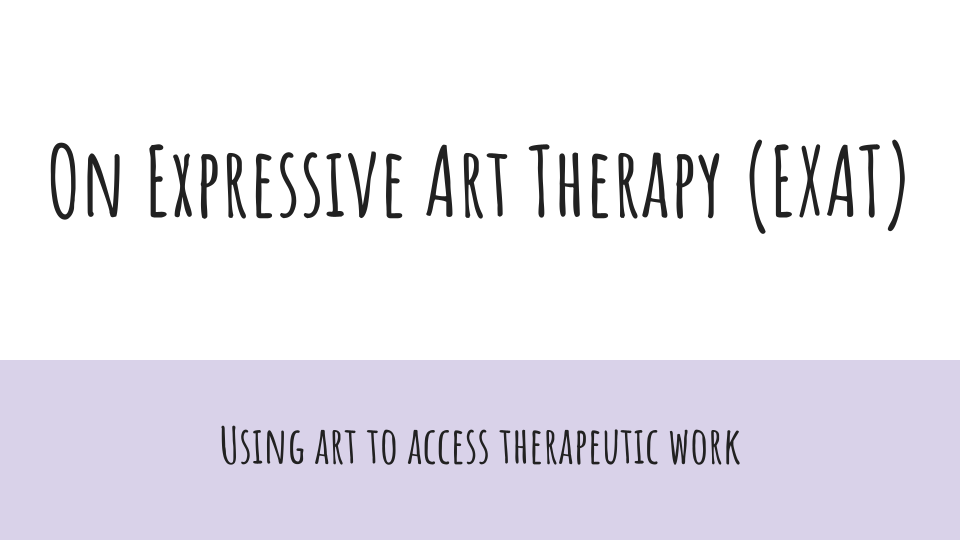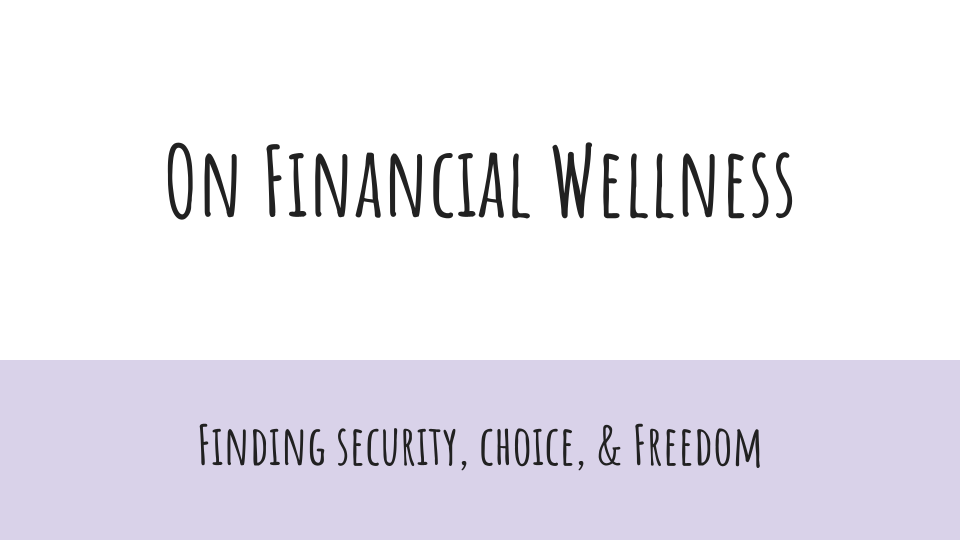On Expressive Arts Therapy (EXAT)
Expressive Arts Therapies (EXAT) is an exciting, multi-modal approach to 'depth' work. This may be assigned in conjunction with other topics, as art is an excellent way to get deeper into your work. The focus is not on how 'good' your art is, but rather what comes up for you as you are creating, and your own analysis of what you made & why you made it. Some examples of EXAT techniques are: journaling, poetry, drawing, painting, clay, dance, singing, movement, and any other creative form of expression.
Below you will find resources related to EXAT.
More about EXAT
What are Expressive Art Therapies?
EXAT is, simply, the use of art to access therapeutic work. Art can range from painting and drawing to writing, dancing, drumming, singing, sculpting, moving, grooving, and simple creative expressions. I believe that everyone has their own definition of art; there is no ‘one way’ to do it. Therefore there is boundless creative opportunity to express your emotions and experience.
The hope is that we do not get hung up on the definition of art. Rather, we can use the idea of creative expression as an avenue for exploring our internal experience about a situation, memory, emotion, or desire.
What is the purpose of this?
The purpose of Expressive Arts Therapy is to give you another tool to explore who you are and how you show up in the world. Sometimes talk therapy is not the most effective modality for creating self-awareness about a particular experience. EXAT gives you another opportunity to understand yourself through more creative means.
Remember that you are building a toolbox. This tool may not be something that you choose to add to your toolbox. That is okay. My hope in including EXAT as a part of this classroom is to expose you to the concept of it and allow you to decide how best to proceed for yourself.
How do I get started?
I believe that the most efficient way to get started is for us to talk more about it in session together. My guess is that you already have different artistic expressions that resonate louder than others - i.e. you prefer writing over drawing, drumming over dancing, etc. Let’s talk about how you can begin to incorporate EXAT into your self-care strategy, and then what you can do with the art you create.
Know that you don’t need to go out and buy a full canvas and paint set. Maybe your work is not to create something that will be complimented, but something that connects to your soul. My guess is that you have all the art you already need waiting for you at home, or out in nature.
How do I interpret my art?
Firstly, your art is not for critical review. While you may find yourself judging the quality of the art, what I am most focused on is the content of it. Therefore we will discuss ways that you can set aside the ‘perfectionist’ and just let your art be what it is.
When observing your art, notice the following:
How you feel looking at it now?
How did it feel creating it?
What colors did you use, and what drew you to those colors (you can substitute the word ‘colors’ for words, movement, rhythm, etc depending on your artistic modality)?
What prompted you to place these images together?
Most importantly, what does this art mean to you?
The beauty of this is that there is no right or wrong way to do it. The theory states that this art is coming from your soul, from some place inside, and you get to interpret it exactly how you want. When you bring your artistic expression to our session I will want to know your interpretation, not mine. Because your inner experience is only known by you. I am just an observer.
What are some different art modalities I can explore?
As stated above, here are a few different modalities that you can explore: painting, drawing, writing, dancing, drumming, singing, sculpting, moving, meditation, collaging, knitting, crocheting, sewing, engaging with nature, and other simple creative expressions. There are countless ways to create and express art, and I believe that you get to define it however you like.
Something that you can explore is layering art, that is, breaking up a 30 minute chunk of art time to not only paint, but to then journal about the painting experience. Or to sculpt, and then compose a creative dance that captures the experience of sculpting. This may sound sort of far out, but through research and my own experience I’ve found that this layering approach can actually deepen the experience and add depth to my own interpretation of the art I’ve created.
Again, we can discuss ways that you can get started in our sessions together.
How does this apply to the rest of my classroom?
This is another tool, another opportunity for self-exploration regarding any given moment or experience. EXAT can be used to capture feelings from childhood, or to better understand your experience of last night’s argument with your partner. There is boundless creative opportunity here.
So, as you are conceptualizing Expressive Arts Therapy and its place with the more concrete sections of this classroom, continue to think about how EXAT can help you better understand your thoughts-emotions-beliefs and how you show up in relationship with yourself and others.
Expressive Arts Therapy Suggested Activities
Take time this week to consider the following activities related to exploring EXAT. There are several different options for you to explore, in case one modality works better for you. Please note that your Conversation Prompts can also make great Journal Topics.
Journal Topics
What are some art modalities that I am drawn to? What do I like about these techniques?
What are some art modalities that I struggle with? Are there specific things about these techniques that I don’t like?
What is my experience with judging my work as ‘good’ or ‘bad’? How possible is it to drop these judgements and just focus on the experience of creating?
What do I anticipate may come up for me as I create art? How can I pay attention to my thoughts / emotions / body sensations as I create art?
What are some healing opportunities where I could use art to deepen my experience and understanding of myself?
Where did I learn to judge my art? Where can I learn to just be open to the process of creating?
Conversation Prompts
With a partner, family member, or friend, discuss your experience with making art. Allow yourself the space to explore different times in your life when you have enjoyed (or not enjoyed) making and sharing art.
Explore supportive ways of examining each other’s art - this can be focusing solely on colors, content, and experience of the piece. Try not to use ‘good,’ ‘bad,’ ‘beautiful,’ or other judgment-based expressions.
Experiential & Artistic Activities
Take time to gather art materials that you currently have in your house. Set an intention for what you hope to get out of this art-making experience. Give yourself at least 30 minutes to create anything you want. Pay attention to how judgement arises as you create. Use your mindfulness tools to let go of the judgement and stay present in the creation.
Make an ‘intentionally bad’ piece of art. This is your worst-case scenario piece of art. Pick a trusted friend, family member, or partner to discuss the process of creating this ‘bad’ piece of art (or journal about it). If your partner tries to rescue you by saying something like, ‘Oh, it’s not that bad,’ ask them to focus on what they see and not them trying to make you feel better. Pay attention to your emotions and thought patterns during and after this experience.
Consider creating a piece of art over many days. This could be a 5-minute timer to draw or paint each morning when you wake. Notice how the piece changes according to your mood and energy. Stay attuned to your colors, work, and process of creating, not how the art may be shifting towards more or less ‘beautiful.’
Additional Resources Related to EXAT
Documents/Books on Expressive Arts Therapy
The Artist’s Way, by Julia Cameron
The Creative Connection, by Natalie Rogers
Ecotherapy: Healing with Nature in Mind, by Chalquist & Buzzell
Wild Mind: A Field Guide to the Human Psyche, by Bill Plotkin
Did you enjoy this chapter? Share the Classroom with your community!
Other Chapters in DEPTH/SPIRITUAL
Check out the Rest of the Classroom!
References
Atkins, A., & Snyder, M. (2018). Nature-based expressive arts. London: Jessica Kingsley.
Banzhaf, S., Ma, L., & Timmins, C. (2019). Environmental Justice: The Economics of Race, Place, and Pollution. Journal of Economic Perspectives, 33(1), 185–208. https://doi.org/http://www.aeaweb.org/jep/
Bessone, E. (2019). Implications and Applications of Eco-Therapy on Art Therapy.. Retrieved from http://search.ebscohost.com/login.aspx?direct=true&db=edsbas&AN=edsbas.4906FA44&site=eds-live&scope=site
Buzzell, L., & Chalquist, C. (2009). Ecotherapy : healing with nature in mind. Sierra Club Books. Retrieved from http://search.ebscohost.com/login.aspx?direct=true&db=cat04042a&AN=app.b3693510&site=eds-live&scope=site
Degges-White, S., & Davis, N. (2018). Integrating the Expressive Arts Into Counseling Practice : Theory-Based Interventions: Vol. Second edition. Springer Publishing Company.
Matsumura, J. L. . (2016). Ecotherapy as a Tool for Mental Wellness. Vermont Connection, 37, 103–110. Retrieved from http://search.ebscohost.com/login.aspx?direct=true&db=eue&AN=114157520&site=eds-live&scope=site
Plotkin, B. A. (2013). Wild mind : a field guide to the human psyche. New World Library.
















